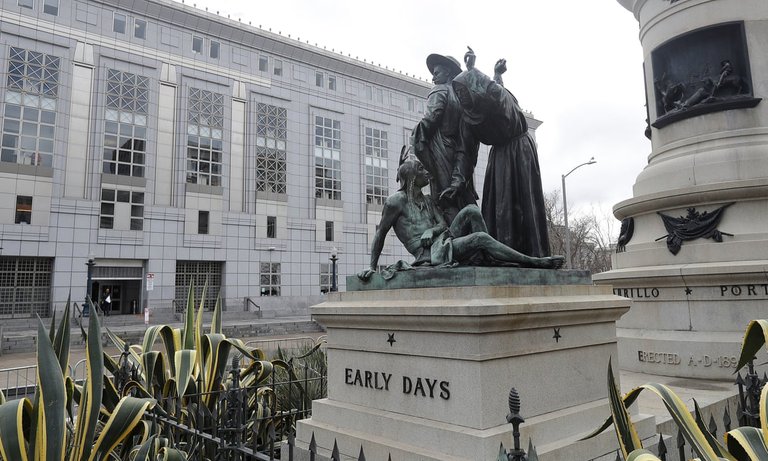The past, the present, and the future collide when public art installations are removed. With many notable monuments in the news, the removal of the "Early Days" in San Francisco has begun a question of the appropriate preservation of the history of public art installations.

"The battle to get the bronze sculpture moved has been roiling for decades, particularly among those of American Indian heritage who were aggrieved by what they saw as an offensive celebration of the subjugation of their people....The Historic Preservation Commission blessed the proposal to take down the sculpture…provided that a plaque be put in its place explaining why it had been removed." ,but those, "who objected to decisions by the city’s Arts Commission and Historic Preservation Commission to take the statue down....appealed that decision, claiming that it was inconsistent with the city’s standards for removing or altering historic artifacts. He also said that removing the statue — and the historic lesson it can convey about the terrible events of the past — was equivalent to destroying it...."

What happens in San Francisco, happens to our nation. Will the opportunity presented by the removal of this work result in the sculpture being placed in a museum and presented both for the reasons it was created and the reasons which it was removed in addition to the historical information about the installation and the location. The historical value of this work is more than the equivalent of our progress, it is living history being written.

“This is what happens when people stand strong and they don’t back down....” After the sculpture was removed, the people gathered and Dee Dee Ybarra, an Ohlone tribal leader, led the crowd in prayer. “Anything is possible. Our day is here. Our time has come.” Those who advocated for the statue’s removal, "....prayed, sang hymns, and looked on morosely at the empty platform." For others including Desirae Harp, a Mishewal Ona*tsáTis (Wappo) and Diné (Navajo) tribe member, this is just a beginning. “I feel like it is a win. I feel good about it. There is still a lot of work to be done....”

Will the public be denied the opportunity of viewing historical examples of public art installations in the future? With the fate of this monument uncertain, discussion turns toward the appropriate location and the manner in which this art installation is presented in the future. Regardless of the political or personal feelings attached, a decision must be arrived at which places the work in the proper location for preservation and should be transferred to an institution for historical study and documentation.

It is notable that this sculpture was installed adjacent to and part of The Pioneer Monument, which consists of a large female figure of Minerva (Roman) or Athena (Greek), the goddess of wisdom and war, representing California on a column with four bronze reliefs. Four piers surround the monument including 'Early Days" and another of a missionary, a Native American, and a vaquero. The "Early Days" statue, even before it was just removed, was transported one block to where it currently stands in 1991. Also, a brass plaque was added to the statue in 1996 in an unsuccessful attempt to appease Native Americans which also has a questionable presentation.
_-_09.jpg)
The monument and public art sculptures, were originally envisioned in 1890 when the model was selected by sculptor Frank Happersberger from a field submissions by trustees. Ground was broken and a cornerstone laid during dedication in 1894. Almost 100 years later the plaque addressing the issue which the Native Americans have brought against the sculpture where acted upon. Just short of three decades later the sculpture has been removed, but as part of a larger monument, as a symbol of the power of public opinion, and as a matter of preservation of historical art the future of the "Early Days" and the understanding which may be gained by studying the past is up to us in the present.

I hope that the monument is placed in an appropriate place and presented in the appropriate light with historical and cultural references that aid the public with an appreciation of the people and history which art reflects in addition to a respect for the preservation of artwork for the future. We have as much or more to learn from art which displeases the eye, but raises the question of why. This artwork has been standing the test of time, but now it is time for it to stand up for it's crimes. After all and according the philosopher Voltaire, "History should be written as philosophy." although he also is quoted as saying that, "History in general is a collection of crimes, follies, and misfortunes among which we have now and then met with a few virtues, and some happy times." He notably also is said to have uttered, "History never repeats itself. Man always does." and "What would constitute useful history? That which should teach us our duties and our rights, without appearing to teach them." -Voltaire

Sources: https://en.wikipedia.org/wiki/Pioneer_Monument_(San_Francisco)
Quotations: https://www.azquotes.com/author/15138-Voltaire/tag/history
Image: https://www.bing.com/images/search?q=voltaire+history+quote&FORM=HDRSC2
In the News: Jose Fermoso https://www.theguardian.com/us-news/2018/sep/24/early-days-statue-removed-san-francisco-native-americans?CMP=Share_AndroidApp_Tweet
Image Source: https://www.theguardian.com/us-news/2018/sep/24/early-days-statue-removed-san-francisco-native-americans#img-3
In the News: Dominic Fracassa https://www.sfchronicle.com/politics/article/Controversial-S-F-Early-Days-statue-taken-13229418.php
Support the arts on Patreon at www.patreon.com/designsthelimit
You may view our Gift Portfolio on Pinterest & Instagram
or Shop for a Personalized Gift on Ebay, Amazon, or Etsy
& Artistic Services direct by Email at [email protected] Verified @Designsthelimit on Minds